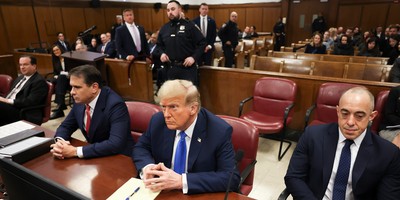A fair bit of the news cycle in the latter half of 2011 has been dedicated to the moans and groans of some spoiled ignoramuses 'protesting' the inherent greed and entrenched power of the nation's wealthiest 1%, and blaming the wealthy themselves (rather than the federal government) for the flaws and injustices present in our economic and legal systems. But if these 'occupiers' were to turn their attention instead to America's poorest 1%, the direct results of big government policies are even more heady and heartbreaking (although, of course, liberal excuses are ever-available to misdiagnose the real problems). In few places is this more evident than on America's 310 Indian reservations, where many of the country's most miserable 1% dwell, writes John Koppisch (I highly recommend reading the entire article):
...To explain the poverty of the reservations, people usually point to alcoholism, corruption or school-dropout rates, not to mention the dusty undeveloped land that doesn’t seem good for growing much and the long distances to jobs. But those are just symptoms. Prosperity is built on property rights, and reservations often have neither. They’re a demonstration of what happens when property rights are weak or non-existent.
The vast majority of land on reservations is held communally. That means residents can’t get clear title to the land where their home sits, one reason for the abundance of mobile homes on reservations. This makes it hard for Native Americans to establish credit and borrow money to improve their homes because they can’t use the land as collateral–and investing in something you don’t own makes little sense, anyway.
For nigh on two centuries, ever since the U.S. government started signing 'treaties' with Indian tribes granting them special 'sovereign' status and a guarantee of government 'help,' American Indians have by and large been left out of the accelerating prosperity and growth that have defined the United States' history. Effectively, the federal government has set up socialist enclaves across the heartland that discourage entrepreneurship, independence, and private ownership in favor of bureaucratic oversight and welfare.
Recommended
I wrote a feature for the November issue of Townhall Magazine about the perpetual state of degradation and despair on many of the United States' Indian reservations, and this two-week old blip in the White House's schedule flew beneath even my radar:
On December 2, 2011, following the 2011 White House Tribal Nations Conference, President Obama met with a small and regionally diverse group of tribal leaders from across Indian Country. Also participating in the meeting were Secretary of the Interior Ken Salazar, Secretary of Health and Human Services Kathleen Sebelius, Secretary of Education Arne Duncan, and Associate Attorney General Thomas Perrelli. ...
Here's the White House's list of some of the "progress" made during the conference:
- -The Department of Energy (DOE) Announced Technical Assistance Opportunities for Tribal Clean Energy Deployment: DOE launched the Strategic Technical Assistance Response Team (START) initiative aimed at advancing clean energy generation in Indian Country and providing federally recognized American Indian and Alaska Native governments with technical assistance to accelerate clean energy project deployment. This effort furthers the Administration and Department’s commitment to provide tribes with the tools and resources they need to foster tribal energy self-sufficiency and sustainability, advancing economic competitiveness and job creation.
- -The Department of the Interior (DOI) Announced Significant Leasing Reform to Spur Commercial, Residential and Renewable Energy Development on Indian Lands: DOI announced a sweeping reform of federal surface leasing regulations for American Indian lands that will streamline the approval process for home ownership, expedite economic development and spur renewable energy development in Indian Country. The proposed rule would modify regulations governing the Bureau of Indian Affairs’ process for approving the lease of surface acres on lands the federal government holds in trust for tribes and individuals. As trustee, Interior is responsible for managing approximately 56 million surface acres in Indian Country.
- -Secretary of the Interior Ken Salazar Named Members to the National Commission on Indian Trust Administration and Reform: As part of President Obama’s commitment to fulfilling this nation’s trust responsibilities to Native Americans, Secretary of the Interior Ken Salazar named five prominent tribal leaders to a national commission that will undertake a forward-looking, comprehensive evaluation of Interior’s trust management of nearly $4 billion in Native American trust funds.
- -The Department of Transportation (DOT) Announced $15 Million to Improve Transit Options on Tribal Lands: DOT announced $15 million in grants to help rural American Indian and Alaska Native tribal governments invest in public transit to improve access to employment centers and promote economic development on tribal lands.
How innovative! In summary, to fight the crushing poverty present on Indian reservations, the federal government is going to subsidize wind and solar energy, 'invest' in transit and infrastructure, and 'evaluate' the many convoluted ways in which the Interior Department gets to hold Indian lands 'in trust.'
In 2008, then-candidate Barack Obama promised to end Washington's long practice of paying "lip service to working with tribes while taking a one-size-fits-all approach with tribal communities across the nation." Although he's only the most recent in a long line of presidents unwilling to relinquish Washington's control over American Indians, let's go ahead and add this to the running list of broken campaign promises.
You don't need government treaties holding sovereign nations' land in trust to preserve your heritage--you can upkeep your own traditions on your own private property just as well, and create a more business/free trade/industry-friendly environment in the process. But under the guise of preserving cultural heritage and making reparations for wrongs long past, the government gets to maintain control over Indian lands and the Indian tribal leaders get to keep squeezing more welfare out of the federal government. A clever ruse, isn't it?

























Join the conversation as a VIP Member